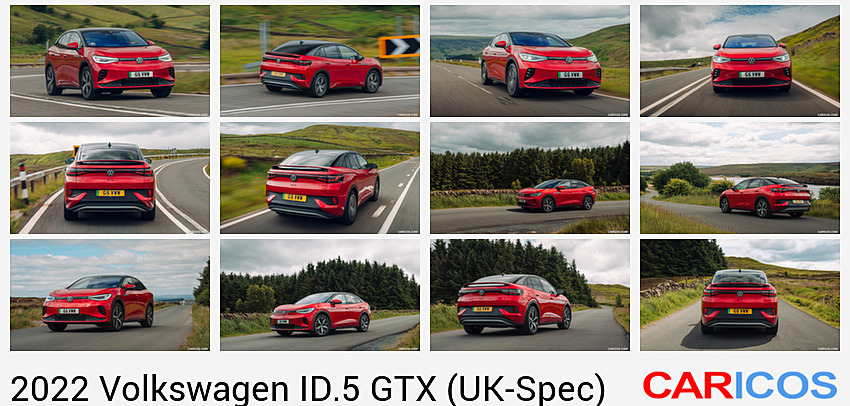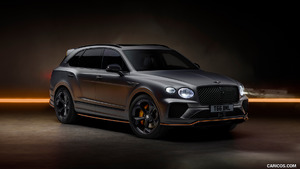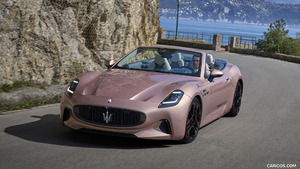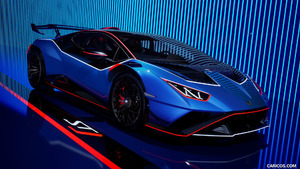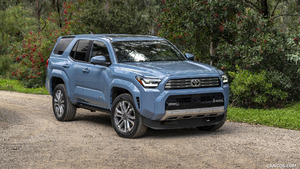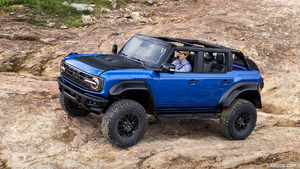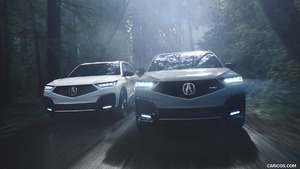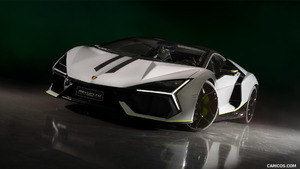Volkswagen ID.5 GTX (UK-Spec)
With its ACCELERATE strategy, Volkswagen is expediting its transformation into a software-oriented mobility provider: Under this strategy, the ID.5 is the sixth fully electric model to join the ID. family, and represents the brand’s wholehearted focus upon software, innovation and e-mobility. It is launched with the availability of two rear-wheel drive derivatives, with either 174 PS or 204 PS, as well as an all-wheel drive ID.5 GTX variant with 299 PS*. The ID.5 is a truly unique model, bringing together the qualities of the ID. family in an elegant body that is as sleek as it is expressive. The ID.5 delivers a strong focus upon spaciousness, along with pioneering solutions for operation, human-machine interface (HMI), Infotainment and assist systems.
The latest generation of ID. software – which makes its debut in the ID.5 – brings benefits including reduced charging times, increased comfort and enhanced vehicle operation. This makes charging even more convenient than refuelling. The ID. software 3.1 also features enhanced, intuitive voice control and an intelligent Electric Vehicle Route Planner. The ID.5 is now the sixth fully electric vehicle to be launched on the basis of the modular electric drive matrix (MEB) and is the current flagship vehicle in the ID. model range.
The spacious ID.5 combines premium quality, sustainability and elegance for a multi-faceted driving experience: the first electrically powered SUV coupé from the brand delivers carbon- neutral mobility and strong performance for a discerning customer. For example, the model’s clever packaging sees its compact drive units mounted on the rear axle or on both axles (ID.5 GTX models), while the short front end houses the radiator and air conditioning system components. The long wheelbase of 2.77 metres creates the foundation for an interior that is as big as those seen in conventional SUVs of the next class up. With a total length of 4.60 metres, the ID.5 offers an unprecedented economy of space to give occupants plenty of room, and a pleasant, luxurious interior ambience.
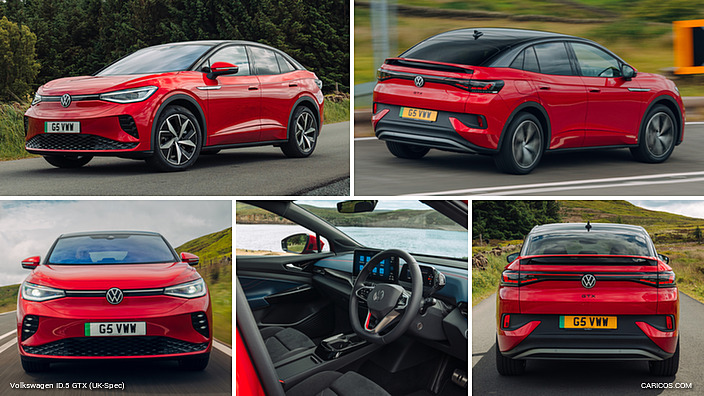 2022 Volkswagen ID.5 GTX (UK-Spec)
2022 Volkswagen ID.5 GTX (UK-Spec)
Even with the ID.5’s sporty coupé shape, the headroom for passengers in the rear is within 12 millimetres of that in Volkswagen’s first E-SUV, the ID.4. The ID.5’s muscular coupé design is unique in its segment, and also contributes its outstanding aerodynamics: a drag coefficient of 0.26 and above, allowing the 77 kWh of energy stored in the lithium-ion battery to provide as much as 316 miles of range from a single charge (WLTP). A quick-charging capacity of up to 135 kW also underpins the ID.5’s suitability for long-distance driving. Eye-catching design features like large wheels and individual details crystallise the ID.5’s sporty yet elegant aesthetic.
Another smart solution for added convenience when charging the vehicle while out and about is the Plug & Charge function. With this feature, the ID.5 will be able to automatically perform an authentication check at Plug & Charge-compatible charging stations, and shares all the requisite data with the charging station. After the certificate has been installed in the vehicle via the We Connect ID. app, encrypted and secure communication (in accordance with the ISO-15118 standard) is started between the ID.5 and charging station as soon as the charging cable is plugged in. After this, charging starts automatically, meaning a charging card is no longer needed for payment. BPlug & Charge is already supported in many large charging infrastructures such as Ionity, Aral, BP, Enel, EON, as well as Iberdrola and Eviny. Further large providers will follow.
In addition to a more convenient charging process, the latest generation of ID. software also offers a number of advantages while charging. When connected to a DC charging station with a high enough output, the ID.5 can now charge up to a maximum capacity of 135 kW – improving on the previous maximum of 125 kW. When charging from five to 80%, this represents a saving of up to nine minutes of charging time compared with previous software versions. This means that the ID.5 is recharged in as little as 29 minutes and the ID.5 GTX in 36 minutes, for the next 242 or 199 miles respectively.
The charging menu – which appears on the ID.5’s 12-inch touch display (standard on Tech and above, optional via Infotainment Pack Plus on Style) – is now even more informative and has a clearer structure with the software generation 3.1. The route calculation function in the navigation system performs intelligent multi-stop route planning for long journeys so the destination is reached as quickly as possible. Any charging stops are calculated on the capacity of charging stations. As a result of this, the program may suggest two short charging operations with high power instead of a long charging stop with low power.
Also enhanced with the latest version of ID. software is the optional Travel Assist system, which keeps the vehicle positioned in its lane, but can now adapt itself to the user’s driving style, with the ability to keep the vehicle further left or right in the lane instead of exactly in the centre, based on the driver’s preference. This is alongside the system’s existing functions of being able to maintain a set distance from the vehicle in front and keep to the set maximum speed. The program features predictive cruise control and a cornering assist function. Here, the vehicle speed can be adapted to valid speed limits and the course of the road (bends, roundabouts, etc.).
Parking is also now even easier thanks to Park Assist Plus with memory function; in addition to taking over complete guidance of the vehicle when parking and driving out of parallel spaces (within the limits of the system), the optional Park Assist Plus with memory function is able to automatically reproduce individual, pre-taught manoeuvres, further boosting convenience and ease-of-use for the driver. The memory function remembers parking procedures covering distances of up to 50 metres at speeds below 25 mph – for example when parking in a carport or garage. All the driver has to do is park their ID.5 manually once, and save the parking action. The vehicle can then repeat the learned parking manoeuvre on its own. Then all the driver has to do is monitor the manoeuvre.
Together with the ID.4, the ID.5 launches into the largest market segment in the world – the compact E-SUV and coupé class. The two models therefore mark a strategic milestone in Volkswagen’s electric mobility campaign. The Group is aiming to become the global market leader for electric mobility by 2025 at the latest, and by 2050, vehicles and the company itself will become carbon-neutral. In the next five years, the company will be investing around 46 billion euros into electric mobility and the hybridisation of its fleet.
Fast facts
- The latest chapter in the Volkswagen ID. family story: the new ID.5 is a style-focused coupe-SUV with in-built sustainability, a focus on equipment, plus practicality and quality
- ID.5 joins the burgeoning ID. family as the third model launched to the public, following the ID.3 and ID.4, and ahead of the ID. Buzz later in 2022
- The model further diversifies the ID. model range into an important new segment, offering a premium equipment list, distinctive design and individual character
- The newcomer also represents a pivotal part of Volkswagen’s nine-strong SUV family, and is the brand’s first electric SUV-coupé
- The ID.5 follows many Volkswagens in having virtues not commonly found together, such as style and practicality, performance and sustainability, quality and charisma, value and abundant equipment
- ID.5 GTX serves as the flagship trim level of the ID.5 range, with greater performance and four-wheel drive. The GTX is to the ID.5, what the GTE and GTD models are for the Golf: more powerful, more dynamically styled and comprehensively equipped, with everyday usability and comfort
- The ID.5 is Volkswagen’s first vehicle with a bi-directional charging function. With this technology, the ID.5 can feed electricity it doesn’t currently need back into the customer’s home network and, in future, will also be able to return electricity to the infrastructure when possible
- The design of the ID.5 closely follows that of the ID. CROZZ and ID. CROZZ II Concepts, first revealed in 2017 at the Motor Shows Auto Shanghai and Frankfurt IAA respectively
- The ID.5 delivers on the promise made by the ID. CROZZ concepts – with up to 316 miles of range available and acceleration from 0 to 62 mph in as little as 6.3 seconds, in addition to style, sustainability and value
- Trim levels for the ID.5 span the entry-grade Style, progressing through Tech line, moving up to Max, with the GTX Style sitting beneath the GTX Max - which serves as the model’s current range-topper. There is a single, 77 kWh battery option, and three power outputs to choose from – 174 PS Pro, 204 PS Pro Performance and 299 PS GTX
- The ID.5 Tech is anticipated to be the top-selling ID.5 trim, and is expected to take around half of UK sales. The top-selling powertrain – also projected to take around 50% of UK sales – is the 77 kWh, 174 PS Pro
- Broad equipment list includes 19-inch ‘Hamar’ alloy wheels, Matrix LED lights front and rear, including 3D dynamic light signals, full glass roof, and the ‘Discover Max’ 12-inch infotainment display, from entry-level Tech trim upwards. Interior upholstery is finished in vegan-friendly ‘leather’ and ArtVelours
- So extensive is the ID.5’s equipment list that only a few options are available: infotainment package plus (ID.5 Style only), paint colour, wheels, a trailer hitch, a 3-pin mains charging cable and an energy efficient heat pump (standard on Max and GTX Max)
- The ID.5 is equipped with the latest version of Volkswagen’s ID. software, which facilitates over-the-air updates to provide a continually improving user experience
- Like all other ID. family models, the ID.5 is delivered to customers as a net carbon-neutral product according to the independent auditing body TÜV NORD, which examines the entire supply chain, manufacturing process and all logistics
- Thanks to the architecture of the MEB platform, the ID.5 has a long wheelbase, which creates an interior as spacious as that of any conventional SUV from the next class up. Despite its compact footprint and dramatic roof-line, the ID.5 offers 549 litres of boot space, rising to 1,561 litres with the rear seats folded
- The intuitive voice control system on the ID.5 is greatly improved over previous versions of the programme. The voice control’s improved recognition rate is now around 95%
- Park Assist Plus with memory function is included from launch, enabling the model to automatically repeat individual, pre-taught manoeuvres. The memory function remembers parking procedures at speeds below 25 mph, covering distances of up to 50 metres, e.g. when parking in a driveway or garage
- Many of the advanced features first seen on the ID.3 are shared with the ID.4 and ID.5, like ID.Light; a central airbag that prevents front seat occupants colliding in a side-impact or rollover; and Car2X, a system that enables the car to exchange information about local hazards with other vehicles and traffic infrastructure
- Volkswagen will have one electric model in all key segments by 2025. The last ICE-powered vehicle will roll off the production line between 2033 and 2035. Volkswagen intends to be climate-neutral by 2050
Technical highlights
The ID.5 arrived in the UK packed with innovative features, intuitive assistance systems, state-of-the-art connectivity and extensive safety technologies to make this Volkswagen a highly sophisticated yet simple-to-operate electric car.
The ID.5 interacts with both its driver and its immediate surroundings intuitively. Aside from the 5.3-inch driver display, a newly developed, centrally positioned, 10-inch touch display provides access to a vast array of information clearly and concisely. A 12-inch touch screen is available on series ID.5 models, via the Infotainment Pack Plus: this is optional on ID.5 Style, and standard on ID.5 Tech, Max, GTX Style and GTX Max.
These crisp, high-resolution screens can be controlled either via their touch screens, or via intelligent natural voice control. “Hello ID.” is all it takes to launch the enhanced voice control function. The system is able to understand freely worded phrases from day-to-day life such as “I’m cold!”, allowing more natural speech to be interpreted by the system, rather than a limited vocabulary of robotic commands. Furthermore, the system can determine whether it is the driver or front passenger speaking, for example, to direct the air conditioning towards the person making the request. The voice control’s improved recognition rate is now around 95%, and the system is also able to allow for interruptions or ask questions. Responses are generated from two sources – online from the cloud, and offline from information stored in the vehicle. Online synchronisation delivers particularly high recognition rates and high-quality results, even when searching for points of interest.
The ID. Light, another feature specific to ID. models, uses different light pulses to signal whether the car is ready to drive, which direction – according to the navigation system – it should turn next or whether the battery is currently being charged. ID. Light also provides support in potentially dangerous situations. It informs and alerts the driver and occupants with conspicuous light signals, for instance when the traffic in front of the vehicle is decelerating quickly. An augmented reality (AR) head-up display is also available on models equipped with the Infotainment Pack Plus (standard on ID.5 Tech, Max, GTX and GTX Max, optionally available for ID.5 Style). It projects key information directly onto the windscreen in the driver’s line of sight – although to the driver’s eye this information appears visually positioned within a range of around three to ten metres ahead. With the AR head-up display, the driver need not take their eyes off the road to access vital information on the move.
Like the ID.3, all controls – including those on the electronically adjustable multifunction steering wheel – are operated using touch, featuring touch-sensitive buttons. Only the electric windows, electronic parking brake and door mirrors are operated using conventional physical switches.
Passive safety equipment includes the Emergency System and a centre airbag, a feature first introduced in the ID.3, and proliferated by the ID.4 and now ID.5. In the event of a side impact or roll-over, this airbag can prevent the driver and front passenger from colliding with each other.
To follow are some technology and safety equipment highlights that appear either as standard or optionally on the ID.5:
We Connect Plus navigation services – The ID.5’s Infotainment package contains the navigation function and services from We Connect Plus, which connect the ID.5 to the owner’s smartphone and the traffic infrastructure. The most important of these features are the navigation services – including the Online Traffic Information, the Online Map Update and the Charging Stations Service, which provides information about nearby charging stations. The Online Route Calculation function in the ID.5 GTX has been updated and improved. On longer journeys, it schedules charging stops so that the destination can be reached quickly, using the current traffic information and forecasts as a basis. Points of interest can be transferred to the car using the free We Connect ID. app. The Internet Radio provides users with access to numerous stations and podcasts.
We Connect Plus vehicle-related services – The second component of We Connect is the vehicle-related services that run on the We Connect ID. app. ID.5 owners can use the app to control the charging process, control the electric stationary air conditioning remotely, check the battery charge level and the vehicle’s range. Also, with the software generation 3.1, the We Connect ID. app now displays driving-related information such as mileage, warning messages and service requirements.
In-Car Application Servers – The ID.5’s electronic architecture follows a fundamentally new concept, in terms of digital experience. Two high-performance computers known as ICAS (In-Car Application Servers) are the main physical components. They bring together a number of tasks that are otherwise spread over a number of small computers – however, basic vehicle functions such as drive system and brake control functions remain on their separate control units. Like on a stationary server, the software architecture is designed to be a broad service platform. This simplifies the exchange of data and functions between the systems.
Travel Assist with swarm data – With two radars in the rear as well as ultrasound technology, Travel Assist with swarm data is able to keep an eye on traffic around the vehicle, as well as – on request – actively supporting the driver when changing lanes on the motorways or dual carriageways at speeds above 56 mph. When activated, the lane change process can be begun and executed by tapping the turn signal. For the operation to be completed, the sensors must have detected no objects around the vehicle, and the capacitive steering wheel must be able to detect the driver’s hands. The vehicle then automatically steers itself into the desired lane. The driver is able to intervene at any time and take over the manoeuvre. If anonymous swarm data is available from other Volkswagen vehicles, the new Travel Assist function is also able to provide support on roads with just one lane marking, for instance on rural roads without a central lane marking. The availability of Travel Assist is increased even further by swarm data, improving comfort and convenience for the driver. The highly precise and anonymised swarm data is generated by several hundred thousand Volkswagen Group vehicles. The vehicle fleet also collects map data with specific features local to the vehicle (e.g. marker lines and road signs) and automatically transmits this information to the cloud. From here, it is tailored and sent to compatible Volkswagen models out on the road. This database is growing all the time, thanks to the large number of participating vehicles.
ID. Light – This standard-fit feature, first seen on the ID.3, is a major step forward in interior design, since it provides both decorative and functional features unlike anything yet seen in the automotive sector. Taking the form of a thin light strip under the full width of the windscreen, ID. Light intuitively assists the driver with another channel of communication. Upon their entry into the car, the system signals to the driver that the ID.5 is ready to go. When the car is due to make a turn and is following a route planned into the navigation system, the light ‘moves’ to the left or right end of the strip correspondingly. If a phone call is received via a connected device the strip will flash green. Should the driver need to brake suddenly, ID. Light issues a warning in intense red, and when the car is charging a green bar builds up from left to right representing the level of battery charge.
Park Assist Plus with memory function – In addition to taking over complete guidance of the vehicle, including steering, accelerating, braking and changing gear when parking and driving out of parallel parking spaces (within the limits of the system), the optional Park Assist Plus with memory function is able to automatically reproduce individual, pre-taught manoeuvres, further boosting convenience and ease-of-use for the driver. The memory function remembers parking procedures at speeds below 25 mph and covering distances of up to 50 metres – for example when parking in a carport or garage. All the driver has to do is park their ID.5 manually once, and save the parking procedure. The vehicle can then repeat the learned parking manoeuvre on its own. Then all the driver has to do is monitor the manoeuvre for safety.
Augmented reality head-up display – The optional augmented reality head-up display, included in the ID.5 Infotainment Pack Plus, follows the ID.3 and ID.4 in being offered to UK customers. The system projects important vehicle information such as its speed onto the windscreen in front of the driver with, for instance, the turn arrows of the navigation system also displayed as they become relevant. However, the driver sees the information as a three-dimensional, staggered image at an apparent distance of around three to ten metres in front of the vehicle. This means that the display appears to be perfectly integrated into the real world outside the car, and the driver need not take their eyes off the road to gain key information. When Adaptive Cruise Control (ACC) or Travel Assist (optional) is active, any vehicle in front of the ID.5 is, from a certain speed, highlighted by the augmented reality head-up display with a luminous marking.
“Hello ID.” – The “Hello ID.” voice control function is also standard in the ID.5. Using the “Hello ID.” verbal trigger, the car can be issued with instructions spoken by the driver and passengers and is capable of understanding a wide variety of commands. For instance, the short sentence “Hello ID., I’m cold!” is sufficient to turn up the heating, while the phrase “Hello ID., play Absolute Radio.” switches the infotainment system to the corresponding station. For the ID.5, with software version 3.1, the program has a recognition rate of around 95%, and can accommodate questions and interruptions for a more natural, conversational function. On models fitted with the panoramic sunroof, even the sun blind can be operated by voice control.
IQ. Drive assist systems – The numerous assist systems installed in the ID.5 as factory-fit items have been bundled under the IQ. Drive umbrella designation. These make driving safer and more relaxed, and can contribute to avoiding accidents or mitigating their consequences. In the full equipment configuration, a front radar sensor, front camera, two rear radar sensors and eight ultrasound sensors monitor the area around the car.
Eco Assistance – A standard-fit system on the ID.5, this is tailor-made for electric driving. It evaluates navigation data as well as road signs detected by the forward-facing camera and, if the ID.5 is approaching a bend or a town boundary, for example, the system can visually indicate when to lift off the accelerator. This apparently simple yet complex calculation allows the car’s drive system to perform optimum energy recuperation, thereby supporting maximum range performance.
Lane Assist – This now familiar lane-keeping system is standard in the ID.5, and works to help prevent the car from unintentionally crossing lane markers on the road. Using a forward-facing camera to monitor any road markings and prevent an unintended deviation, the system intervenes only if the indicators are not activated so if the driver does intend to change lanes and signals their intention, the intelligent system recognises this and switches off. The system is updated with the ability to remain in lane without sticking rigidly to the exact centre of the lane, based on the user’s driving style and preferences.
Front Assist – As its name suggests, this system monitors the area in front of the ID.5 via the car’s multifunction camera and reacts to potential imminent collisions via warnings and, if required, braking interventions. Meanwhile, the ID.5’s oncoming vehicle braking when turning function monitors the opposite lane when turning off, issuing a warning and/or braking the car automatically if it anticipates an emergency. Swerve support helps the driver to navigate obstacles in the road by providing corresponding steering interventions and, in order to avoid minor parking collisions, the standard audible Park Distance Control has an integrated manoeuvre braking system.
Emergency Assist – This potentially life-saving feature in the Assistance Pack Plus, brakes the car to a standstill if the person behind the ID.5’s steering wheel is no longer capable of doing so. If possible, it also guides the vehicle to the edge of the road. As soon as the sensors detect no steering, braking or acceleration activity, the system activates various escalation stages. Initially, Emergency Assist attempts to alert or wake the driver by steering jerks and, if this fails to generate a response, an emergency stop is initiated. The hazard warning lights are activated automatically and the car completes some minor steering manoeuvres within its lane to draw the attention of other road users to the hazardous situation. ACC prevents collisions with the traffic ahead, while the system brakes the vehicle continuously to a standstill.
IQ. Light – Not to be confused with ID. Light, the IQ. Light headlights are LED matrix headlights. A bank of 18 individual LEDs make up the light modules of each headlight, and 11 of these can be individually dimmed or switched off to intelligently control the main beam without having to switch it off or down altogether, always illuminating the road as brightly as possible without dazzling other road users. Modes for urban driving, motorway driving and poor weather are among the numerous automatically-controlled settings, as well as a function to avoid glare from road signs reflecting the beam.
Over-the-air updates – Alongside the ID.3 and ID.4, the ID.5 offers over-the-air updates for continual improvement of the ownership experience. Using the car’s mobile data connection to remotely update its programming, the user can choose when to schedule these updates when prompted that new software is ready and pending, to have the car as up to date as possible, at the most convenient time. In the future, Volkswagen will update the software in its ID. cars every twelve weeks. Software patches for the current range of ID. models can reach and update up to 35 control units via the Over-the-Air Updates.
Connectivity highlights – The ID.5 is delivered to the customer with a high level of connectivity as standard. The model is he first Volkswagen to feature USBPD ports (Power Delivery). Located in the passenger area, these more potent USB-C ports are able to charge larger, more powerful devices such as laptops with up to 45 watts of power. The Comfort mobile phone interface links the smartphone aerial with the vehicle aerial and enables contactless charging for devices with wireless charging. The standard App-Connect function allows common smartphone mirroring technology such as Apple CarPlay and Google Android Auto to be projected onto the native Infotainment display.
Trim levels and equipment
The ID.5 is notable for its comprehensive equipment list – the very few grey spaces in the specification table below demonstrate just how generously the model has been specified, with only the availability of the Infotainment Pack Plus and heat pump as options separating the entry-level Style from the next-up Tech trim, which features these items as standard. Like the other ID. models, these specifications are each based around a different combination of equipment packs – features bundled into logical groups for easy indexing when a customer is selecting their vehicle.
These five distinct specifications are:, Style, Tech, Max, GTX Style and GTX Max. Each benefits from the largest battery pack currently offered in the ID. family – a 77 kWh unit capable of returning as much as 316 miles from a single charge. Three powertrain options are also offered on the ID.5; the ‘Pro’ with 174 PS; the ‘Pro Performance’ with 204 PS; and the GTX, with 299 PS1. This structure allows easy configuration of the ID.5, both in terms of equipment and power.
|
ID.5 – specifications, power and battery options
|
|||||
|
|
Style |
Tech |
Max |
GTX Style |
GTX Max |
|
Motor and battery combinations available for this model… |
|
||||
|
Pro |
√ |
√ |
√ |
|
|
|
Pro Performance |
√ |
√ |
√ |
|
|
|
GTX |
|
|
|
√ |
√ |
|
Packs included with this model… |
|||||
|
Interior Style |
√ |
√ |
√ |
√ |
√ |
|
Interior Style Plus |
|
√ |
√ |
|
√ |
|
Interior Top Sport Plus |
|
|
√ |
|
√ |
|
Infotainment Pack |
√ |
√ |
√ |
√ |
√ |
|
Infotainment Pack Plus |
|
√ |
√ |
|
√ |
|
Comfort Pack |
√ |
√ |
√ |
√ |
√ |
|
Comfort Pack Plus |
√ |
√ |
√ |
√ |
√ |
|
Assistance Pack |
√ |
√ |
√ |
√ |
√ |
|
Assistance Pack Plus |
|
√ |
√ |
|
√ |
|
Design Pack |
√ |
√ |
√ |
√ |
√ |
|
Design Pack Plus |
√ |
√ |
√ |
√ |
√ |
|
Sport Pack Plus |
|
|
|
√ |
√ |
|
Wheels |
19-inch ‘Hamar’ alloy |
19-inch ‘Hamar’ alloy |
19-inch ‘Drammen’ alloy |
20-inch ‘Ystad’ alloy |
20-inch ‘Ystad’ alloy |
This simpler approach to ordering and specification, plus the ID.5’s comprehensive level of equipment makes the offering even more transparent for customers, and ensures the factories can build and deliver cars faster. So, an ID.5 customer follows a simple, intuitive decision-making process: choose your model; choose your interior and exterior colours; choose your wheel design; then choose your optional extras – which comprise the Infotainment Package Plus (for the ID.5 Style), as well as deliberately limited options such as a heat pump. Beyond that, only a variety of accessories can be added, such as tow bars and bike carriers, to keep the ID.5 buying-process clear and simple.
Batteries, motors and running gear
Three model variants, a 77 kWh battery and two drivetrains
The ID.5 is offered in the UK in Pro, Pro Performance and GTX setups, all of which use the largest 77 kWh ‘Pro’ battery. Five series specifications – Style, Tech, Max, GTX Style and GTX Max – are currently available, with Style, Tech and Max available with Pro and Pro Performance powertrains, and the GTX-badged models being bestowed with the 299 PS, all-wheel drive setup. With the optional electric ball coupling, the ID.5 Pro and ID.5 Pro Performance can pull up to 1,200 kg (braked, with an 8% gradient), while the ID.5 GTX can pull as much as 1,400 kg.
|
ID.5 battery and powertrain configurations: key data
|
|||||||
|
Name |
Available in |
Battery size, (net, kWh) |
Usable range (miles, WLTP, combined) |
Power (PS) |
Torque (Nm) |
0-62 mph (sec) |
Range from 30 min 100kW rapid charge (miles) |
|
Pro |
Style, Tech, Max |
77 |
316 (Style), 313 (Tech), 311 (Max) |
174 |
310 |
10.4 |
242 |
|
Pro Performance |
Style, Tech, Max |
77 |
316 (Style), 313 (Tech), 311 (Max) |
204 |
310 |
8.4 |
242 |
|
GTX |
GTX Style, GTX Max |
77 |
300 (GTX) 296 (GTX Max) |
2991 |
460 |
6.3 |
199 |
In the ID.5 Pro and Pro Performance, the model is rear-engined, and in all but the GTX, it is rear-wheel drive – harking back to the earliest engineering roots of the brand and the debut of the original Beetle. For the rear-engined variants, the electric motor, capable of spinning up to 16,000 rpm, sits above the rear axle just ahead of the rear wheels, and sends its torque to a single-speed gearbox with differential. This set-up creates ideal conditions for agile handling and impressive traction, while also permitting a small turning circle of just 10.2 metres.
Models under the GTX are distinct in that they are the only ID. models to offer all-wheel drive, with the front wheels driven by a second electric motor, facilitating dual-motor all-wheel drive for the first time on a Volkswagen. The front motor is an asynchronous unit on the front axle, while the rear wheels are powered by a permanently excited synchronous motor on the rear axle. The front motor weighs around 60 kg in total, and like the rear motor, the drives the wheels via a single-speed gearbox and a differential.
One of the main strengths of the permanently excited synchronous motor (PSM) in the ID.5 is its efficiency, which is measured at above 90% in almost all driving situations. Volkswagen has supported this engineering achievement by using an innovative technology known as a hairpin winding: the stator’s coils are made from square copper wires, which after bending are visually similar to hairpins. This hairpin winding technique enables the wires to be packed more tightly. As result, there is more copper in the stator – power and torque are increased, while cooling is more efficient. Together, the gearbox, power and control electronics and the electric drive motor itself weigh roughly 90 kg and in terms of size could fit into a typical gym bag.
Furthermore, the drivetrain is so quiet that it can barely be heard outside the car. Indeed it is so noiseless that a loudspeaker emitting a synthetic electronic engine sound up to a speed of around 20 mph is fitted in order to warn passers-by that the car is operating near them.
All gentle and moderate deceleration is also performed by the electric drive motors using recuperation. The highly efficient motor in the rear normally deals with this deceleration alone, though the ASM can also contribute when braking from high speeds. The ID.5 can brake electrically alone up to a deceleration rate of around 0.3 g, which corresponds to an energy recovery level of more than 100 kW. The hydraulic wheel brakes do not step in until above this point. This transition is practically unnoticeable for the driver, and recuperation remains active almost until the vehicle comes to a stop.
In the B (Brake) position, the electric drive motor functions as a generator and feeds power back into the battery. This also happens when the vehicle is braked: the electric motor performs deceleration on its own up to around 0.3 g, which represents the majority of everyday situations. The conventional hydraulic wheel brakes also come into play above 0.3 g, and the transition to assisted braking is practically unnoticeable.
When it comes time to recharge, the ID.5 can handle either alternating current (AC) or direct current (DC) and has full fast-charging capability. All versions charge with a power rating of up to 135 kW (DC), which translates to gaining a range of up to 242 miles in just 30 minutes.
The car’s battery housing is an aluminium lightweight structure in a scalable truss design. The housing is bolted to the body, thereby supporting rigidity. The battery modules each integrate 24 pouch cells with a flexible outer sleeve. The temperature of the cell modules is regulated by a floor plate with integrated water channels which is connected to a coolant circuit with air conditioning compressor and electric heater. The thermal management system is designed to ensure that the battery is, as far as possible, operated in the ideal temperature range (around 25 degrees Celsius). This optimises power output, fast DC charging and the battery service life.
Volkswagen guarantees that the battery will still have at least 70% of its original capacity after eight years of operation or 100,000 miles. A second coolant circuit in the ID.5 supplies the electric drive motor, the power and control electronics and the charger.
Running gear
Sitting as it does on the all-new MEB platform, the ID.5 sports a low centre of gravity that helps to deliver dynamic handling, to match the model’s dynamic design. The rear-wheel drive set-up and packaging of the non-GTX ID.5 models create ideal prerequisites for what some might see as sporty driving characteristics, which are built upon by the more powerful GTX variant. The vehicle’s high-voltage battery is located between the axles at the lowest point of the car, and regardless of trim variant the ID.5’s weight distribution never deviates from the ideal 50:50 position by more than one percent.
Following the model set by the ID.3 and ID.4, the ID.5 is engineered to be nimble in the city, agile on country roads and relaxed on the motorway. The front axle follows the MacPherson design, while the steering is translated with a 15.9:1 ratio. The steering system is located ahead of the front axle, which guarantees improved stability during fast cornering. At the rear is a complex new development – a compact five-link suspension with a subframe that is elastically connected to the body. Parts of the suspension are made of lightweight aluminium to reduce weight.
Vehicle Dynamics Manager, first seen on the new Golf GTI, is part of the control system in the ID.5, and is standard-fit across all models. The system networks the electronic stability control (ESC) and all of the control units for the electric motor, along with any power electronics such as the XDS electronic differential lock and DCC (standard on ID.5 Max, GTX Style and GTX Max, or optionally available on ID.5 Style and Tech via Sport Pack Plus). It works to achieve optimum driving and steering behaviour in every situation. While rear-wheel drive cars can naturally have a tendency towards oversteer, this networking of systems ensures that the rear wheels of the ID.5 find grip in every situation – during full acceleration, when cornering fast and when decelerating by brake recuperation. The system is extremely fast, making adjustments, as necessary, every millisecond.
The ID.5 is equipped as standard with 19-inch wheels. Across the model’s range, there is a choice of alloy wheels ranging in size from 19 to 21 inches, with all of them aerodynamically optimised. In spite of the large wheels, which of course require corresponding space in the wheel housings, the ID.5 requires a turning circle of just 10.2 metres – impressively small for a car in this class. The ID.5 GTX has a slightly larger turning circle of 11.6 metres, owing to the need to accommodate its front axle motor.
All ID.5 tyres have a low rolling-resistance. Front tyres on all models all 235 mm wide, with the profile differing depending on the wheel size. The staggered setup means that the rear tyres are 255 mm wide.
To support the electric motor’s recuperation function, powerful brakes with a disc diameter of up to 358 mm are fitted at the front, which are 1 mm larger than those on the Golf R. The rear wheels are equipped with drum brakes. These drum brakes boast exceptional robustness and its pads are designed for the entire service life of the car. Corrosion should not be an issue as the brakes are rarely used in everyday driving, due to energy recuperation playing its part in the deceleration process.
Reflecting its position at the top of the ID.5 range, and its status as a swifter model in the ID.5 line-up, the GTX is upgraded to add additional performance to the package. The Sports Package adds sports suspension which lowers the model’s height by 15 mm, and adds progressive steering with a range of 15.9:1 to 14.5:1, with the steering ratio becoming increasingly more direct the more the steering wheel is turned. The GTX Max increases this focus further by adding Dynamic Chassis Control (DCC) adaptive dampers, with adjustable settings permitting modes for high comfort and sharp handling, and numerous variations in between. The GTX badge is to the ID.4 and ID.5, what the GTE and GTD are to the Golf – higher-performing models with additional power and equipment.
MEB platform
The ID.5 is the third Volkswagen to be based on the newly developed, modular electric drive matrix – known as MEB. While the ID.3 was the first model to use this platform, it is the ID.4 that marked the global roll out of the platform, and the ID.5 that pushes the platform into a key new segment – the E-SUV coupe. Across the Volkswagen Group it is envisaged that 19 million vehicles will be built globally on the MEB platform by 2030.
As a way of offering affordable e-mobility to as many people as possible, Volkswagen developed the modular electric drive matrix (MEB), a platform that complements the previous modular transverse toolkit (MQB). The first MEB-based volume model was the ID.3 and, while the exterior dimensions of that car are not dissimilar to the best-selling Golf, with the help of the new MEB architecture it is able to offer a remarkably spacious interior more aligned to that of the Passat class. The ID.5 is the same, and alongside the ID.4, has a footprint comparable to the Tiguan, yet offers interior space more akin to the Tiguan Allspace – despite its elegant curving roof line. The key to this achievement is the newly conceived platform. The MEB platform is now used across the majority of Volkswagen Group brands serving the mass market.
Thanks to the design approach taken with MEB, there are numerous benefits in terms of the package, such as the efficient arrangement of drive components and auxiliary units, as well as the obvious space advantages in the vehicle interior.
The ID.5’s electric drive primarily consists of the permanent-magnet synchronous motor including power electronics and gearbox, which have all been integrated into the rear axle for rear-wheel drive models. A high-voltage battery is efficiently arranged in the underbody to save space, while auxiliary units – such as the air conditioning compressor and steering rack – have been integrated into the vehicle’s front end.
The MEB’s power electronics control the high-voltage energy flow between motor and battery and, in this process, the system converts the direct current (DC) stored in the battery to alternating current (AC) for the drive motor. The 12 V DC electrical system is simultaneously supplied with low voltage by a DC/DC converter. Power is transmitted from the motor to the rear axle using a single-speed gearbox. Together, motor, power electronics and gearbox form a compact unit.
Design
The ID.5’s stand-out feature is its design. With an SUV-coupe silhouette first seen on the ID.CROZZ concept, the model is both familiar and fresh, powerful, confident and elegant, whether in entry-level Pro or range-topping GTX forms. The short overhangs and large wheels enhance the strong and dynamic appearance of the ID.5, underpinning its sporting appeal. The model is 4.60 metres long, 1.85 metres wide and 1.61 metres tall. Roof rails are fitted as standard, and the permitted roof load is 75 kg.
The ID.5 Pro and the ID.5 Pro Performance achieve a very low drag coefficient of 0.26, and in the ID.5 GTX, the drag coefficient is 0.27. The decisive factor for the aerodynamic properties of the ID.5 is its body shape, with the greenhouse, dropping gently to the back and becoming increasingly narrow towards the rear. Directly influenced by the air flow are the spoiler, the sculptured shape of the tail light clusters and lifted diffuser insert, which work together with the additional goal of reducing down force on the rear axle.
The flush door handles on the ID.5 are also designed to optimise air flow for minimal drag, as are the wheel rims with their flat design. The electric radiator roller blind in the vehicle’s front end does not open until the power units need cooled air – only then does the system open, allowing air through the cooling channels. Even across the underbody, small spoilers and trim panels guide the flow of air for optimal performance, both in efficiency and aerodynamics.
The high front underlines the E-SUV-coupé’s robust power, while the flat angle of the A-pillars, which have been pulled forwards, adds a new, elegant flow to the roof line – this stretches out close to the body and runs into the extended D-pillars. The athletic shoulder lines make for a powerful, assertive aesthetic. At the rear, horizontal lines emphasise the width, with the full-length lighting strip a key identifier of the ID.5.
LED matrix headlights, called IQ.LIGHT, are fitted as standard to the ID.5, and illuminate the road as brightly as possible without dazzling other road users. Each headlight module is made up of 18 LED units, eleven of which can be individually switched off and dimmed. A separate spotlight expands the lighting package. When the lighting is switched on, a strip of light connects the headlights to the Volkswagen badge across the front of the vehicle. In the ID.5 GTX, three individual LED units extend the signature light into each of the outer air intakes. These have the additional function of ‘following’ the driver – or whoever has the key fob – by rotating on a vertical access as they make their way around the front of the vehicle, mimicking the tracking of an animal’s eyes.
The brake light creates an X shape, while the dynamic turn signal sweeps from inside to out. In vehicles equipped with the LED matrix headlights, animated lighting patterns run through the tail light clusters to welcome and say goodbye to the driver. The driver can choose between various animations in the relevant HMI menu.
Interior design
The interior of the ID.5 is designed around the Open Space concept. Getting in is easy, and visibility is good because the driver and up to four passengers sit comfortably high up. In the second row of seats, there is a similar amount of leg room to a Tiguan Allspace, while the head room for all five passenger is slightly better too. The volume of the ID.5’s luggage compartment is 549 litres, making it slightly bigger than that of the ID.4, in spite of its sleek roof line.
When the rear seat backrests are folded down, the volume reaches 1,561 litres when loaded to roof height. The Plus assistance package contains the electric Easy Open & Close boot lid, which brings additional convenience, allowing the boot lid to be opened and closed with a mere foot movement. The ID.5’s upholstery fabrics differ depending on the interior design, but are always free from animal products. The ID.5 GTX has seats featuring a combination of textile and leatherette. Depending on the specification package, the centre seat panels may be trimmed with ArtVelours, a microfibre material that includes recycled materials such as PET bottles.
Getting in the ID.5 is easy, and visibility is ideal because the driver and the passengers – particularly those in the rear – sit comfortably high up. The front seats are equipped with armrests on the inside, which can be individually and flexibly adjusted to the driver and front passenger. In between the two armrests, there is the long centre console, which is particularly versatile. For instance, the customer can individually select the position of the drink holder. While the vehicle is moving, noise levels are very low – the E-SUV coupé utilises its abundant power almost silently, thanks to its sophisticated aero-acoustic concept, as well as complex insulating measures in the vehicle body.
The ID. Light uses different light pulses to signal whether the car is ready to drive, which direction – according to the navigation system – it should turn next or whether the battery is currently being charged. ID. Light also provides support in potentially dangerous situations. It informs and alerts the driver and occupants with bold lighting signals, for instance when the traffic in front of the vehicle is decelerating quickly. Moreover, ID. Light can also support and supplement instructions from the navigation system with lighting signals. For example, it can indicate that the driver needs to move into the inside lane before taking a motorway exit or that they should take their foot off the accelerator in order to coast efficiently according to their speed. All colours and animations follow a carefully composed visual language that is friendly, universal and easy to understand, giving drivers the information they need while safely keeping their eyes on the road.
Servicing and warranty
Volkswagen vehicles powered only by an electric motor such as the ID.5 require a simple Fixed Service schedule as follows: inspection service – every two years, with unlimited mileage.
Warranty
The ID.5 has a three-year (first- and second-year manufacturer operated, third-year retailer- operated) / 60,000-mile mechanical warranty. In addition, it comes with a 12-year body protection guarantee, three-year paint warranty and a year’s membership of Volkswagen Assistance which includes European breakdown cover. The latter can be extended at minimal cost to the customer.
Additionally, Volkswagen offers an eight-year EV battery warranty which takes the form of a guarantee for eight years or 100,000 miles/160,000 km (whichever is soonest), on all material or manufacturing defects.
Gradual reduction in battery capacity over time is integral to the nature of the component, and does not represent a defect under the terms of this guarantee, as long as the reduction in capacity is not in excess of the value specified for this vehicle in the owner’s manual.
With the exception of the warranty term, all warranty conditions stipulated by the Volkswagen Retailer selling the vehicle (prerequisites, criteria for freedom from defects, exclusions, settlement of claims, entry into force and start of extended warranty term, scope of application etc.) also apply to the high voltage battery.
Technical data
|
|
ID.5 Pro (Style, Tech, Max) |
ID.5 Pro Performance (Style, Tech, Max) |
ID.5 GTX (GTX Style, GTX Max) |
|
Battery capacity (net) |
77 kWh |
77 kWh |
77 kWh |
|
Max power |
174 PS (128 kW) |
204 PS (150 kW) |
299 PS1 (220 kW) |
|
Max torque |
235 Nm |
310 Nm |
460 Nm |
|
Max speed |
99 mph |
99 mph |
112 mph |
|
Acceleration, (0-62 mph) |
10.4 sec |
8.4 sec |
6.3 sec |
|
Energy consumption |
4.0-4.1 miles/kWh |
4.0-4.1 miles/kWh |
3.8-3.9 miles/kWh |
|
Range (WLTP combined) |
311-316 miles |
311-316 miles |
296-300 miles |
|
Height |
1,615 mm |
1,640 mm |
1,637 mm |
|
Width (inc. door mirrors) |
2,108 mm |
2,108 mm |
2,108 mm |
|
Width (exc. door mirrors) |
1,852 mm |
1,852 mm |
1,852 mm |
|
Length |
4,599 mm |
4,599 mm |
4,582 mm |
|
Wheelbase |
2,771 mm |
2,771 mm |
2,771 mm |
|
Turning circle |
10.2 m |
10.2 m |
11.6 m |
|
Kerb weight |
2,042 kg |
2,042 kg |
2,167 kg |
|
Battery weight |
493 kg |
493 kg |
493 kg |
|
Boot volume (seats up/down) |
549 / 1,561 litres |
549 / 1,561 litres |
549 / 1,561 litres |
|
Max. trailer load (braked) |
1,000 kg |
1,000 kg |
1,200 kg |

